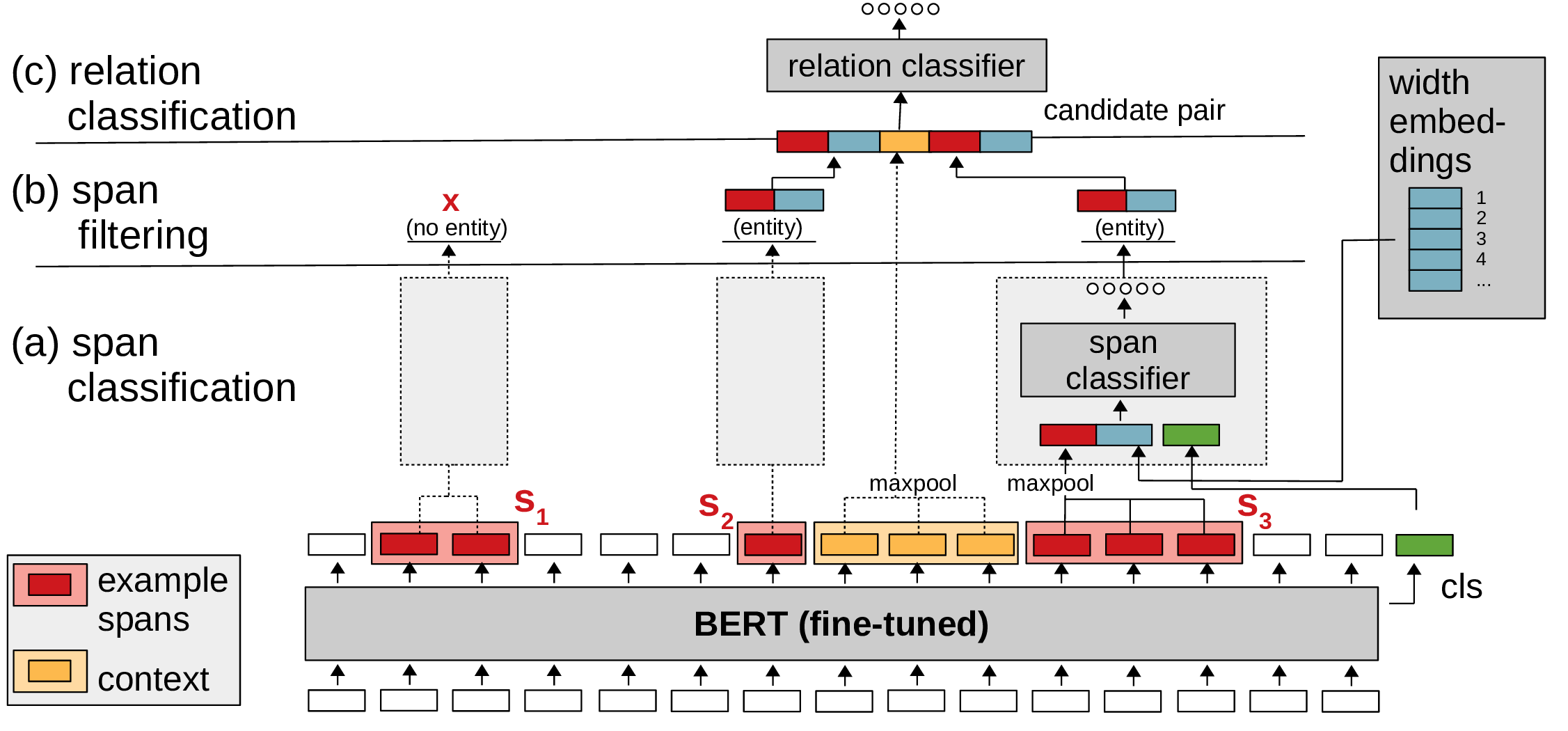PyTorch code for SpERT: "Span-based Entity and Relation Transformer". For a description of the model and experiments, see our paper: https://arxiv.org/abs/1909.07755 (accepted at ECAI 2020).
- Required
- Python 3.5+
- PyTorch 1.1.0+ (tested with version 1.3.1)
- transformers 2.2.0+ (tested with version 2.2.0)
- scikit-learn (tested with version 0.21.3)
- tqdm (tested with version 4.19.5)
- numpy (tested with version 1.17.4)
- Optional
- jinja2 (tested with version 2.10.3) - if installed, used to export relation extraction examples
- tensorboardX (tested with version 1.6) - if installed, used to save training process to tensorboard
Fetch converted (to specific JSON format) CoNLL04 [1] (we use the same split as [4]), SciERC [2] and ADE [3] datasets (see referenced papers for the original datasets):
bash ./scripts/fetch_datasets.sh
Fetch model checkpoints (best out of 5 runs for each dataset):
bash ./scripts/fetch_models.sh
The attached ADE model was trained on split "1" ("ade_split_1_train.json" / "ade_split_1_test.json") under "data/datasets/ade".
Evaluate CoNLL04 on test dataset:
python ./spert.py eval --config configs/example_eval.conf
Train CoNLL04 on train dataset, evaluate on dev dataset:
python ./spert.py train --config configs/example_train.conf
- To train SpERT with SciBERT [5] download SciBERT from https://github.com/allenai/scibert (under "PyTorch HuggingFace Models") and set "model_path" and "tokenizer_path" in the config file to point to the SciBERT directory.
- You can call "python ./spert.py train --help" or "python ./spert.py eval --help" for a description of training/evaluation arguments.
- Please cite our paper when you use SpERT:
Markus Eberts, Adrian Ulges. Span-based Joint Entity and Relation Extraction with Transformer Pre-training. 24th European Conference on Artificial Intelligence, 2020.
[1] Dan Roth and Wen-tau Yih, ‘A Linear Programming Formulation forGlobal Inference in Natural Language Tasks’, in Proc. of CoNLL 2004 at HLT-NAACL 2004, pp. 1–8, Boston, Massachusetts, USA, (May 6 -May 7 2004). ACL.
[2] Yi Luan, Luheng He, Mari Ostendorf, and Hannaneh Hajishirzi, ‘Multi-Task Identification of Entities, Relations, and Coreference for Scientific Knowledge Graph Construction’, in Proc. of EMNLP 2018, pp. 3219–3232, Brussels, Belgium, (October-November 2018). ACL.
[3] Harsha Gurulingappa, Abdul Mateen Rajput, Angus Roberts, JulianeFluck, Martin Hofmann-Apitius, and Luca Toldo, ‘Development of a Benchmark Corpus to Support the Automatic Extraction of Drug-related Adverse Effects from Medical Case Reports’, J. of BiomedicalInformatics,45(5), 885–892, (October 2012).
[4] Pankaj Gupta, Hinrich Schütze, and Bernt Andrassy, ‘Table Filling Multi-Task Recurrent Neural Network for Joint Entity and Relation Extraction’, in Proc. of COLING 2016, pp. 2537–2547, Osaka, Japan, (December 2016). The COLING 2016 Organizing Committee.
[5] Iz Beltagy, Kyle Lo, and Arman Cohan, ‘SciBERT: A Pretrained Language Model for Scientific Text’, in EMNLP, (2019).
